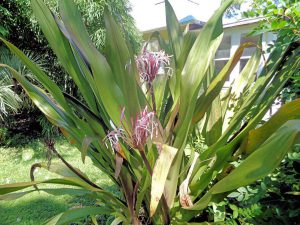
As we creep back to normal after the hurricane, one perennial plant comes to mind that every landscape should have – the flowering bulb called the crinum lily. There are many types and cultivars suitable to keep a collector going for years. This is a big plant with an equally big, intricate and stunning flower.
The crinum lily is a large plant with green to purplish, strap-like leaves at least three-feet long, and four inches wide. The crinum forms a big rosette of leaves growing up to seven feet across, and up to five feet high. The bulb which forms underground is one of the biggest in nature – some weighing over twenty pounds! Perfectly hardy for our area, the crinum prefers part-shade, but will grow in both sunny to part-shade sites with well-drained soil. This large perennial is suited to mass planting, as an accent plant, or when planted with palms – all making for a spectacular tropical sight. A planting of crinum lilies takes little care and offers moderate drought and salt tolerance making them good coastal planting material as well.
Beyond the foliage is the much-anticipated flower head. A large stem supports a cluster of sweet-smelling flowers that open up and flare out into a large, foot-wide, corona of delicate petals intersecting with colorful filaments. Summer provides the most colorful flower display, and, depending on the species and variety, ranges from white, pink, deep rose, or even striped. Flower heads can occur year-round and develop large seed pods which often weigh themselves down to the ground. Multiple huge seeds develop and readily sprout forming new plants. Bulblets from mature plants can also be divided during the winter for quick and easy propagation.
There are just a couple of negatives to mention associated with crinum lilies. First, those giant lubber grasshoppers are perhaps the worst insect pest for crinums and others in the lily family. So, if you have a history of lubbers, perhaps consider passing on crinums. Some leaf spot diseases are also known to develop on occasion causing red blotches and blemishes to mar the foliage. Crinum lilies are toxic, and another name for this plant is “poison bulb” as all parts are poisonous. As such, keep this in mind and take precautions if children and pets are present.
Big and beautiful, the crinum is a Florida-Friendly Landscaping™ plant recommended for our area. For more information on all types of flowering bulbs suitable for our section of Florida, you can also call the Master Gardener Volunteer Helpdesk on Mondays, Wednesdays and Fridays from 1 to 4 pm at 764-4340 for gardening help and insight into their role as an Extension volunteer. Ralph E. Mitchell is the Director/Horticulture Agent for UF/IFAS Extension – Charlotte County. He can be reached at 941-764-4344 or ralph.mitchell@charlottecountyfl.gov. Connect with us on social media. Like us on Facebook @CharlotteCountyExtension and follow us on Instagram @ifascharco.
Resources:
Gilman, E. F. (2014) Crinum spp. Crinum Lily. The University of Florida Extension Service, IFAS.
The Florida-Friendly Landscaping™ Guide to Plant Selection & Landscape Design (2010) The University of Florida Extension Services, IFAS.
Landre, C. (2022) Crinum Lily. Crinum spp. South-Florida-Plant-Guide.com.
 1
1
